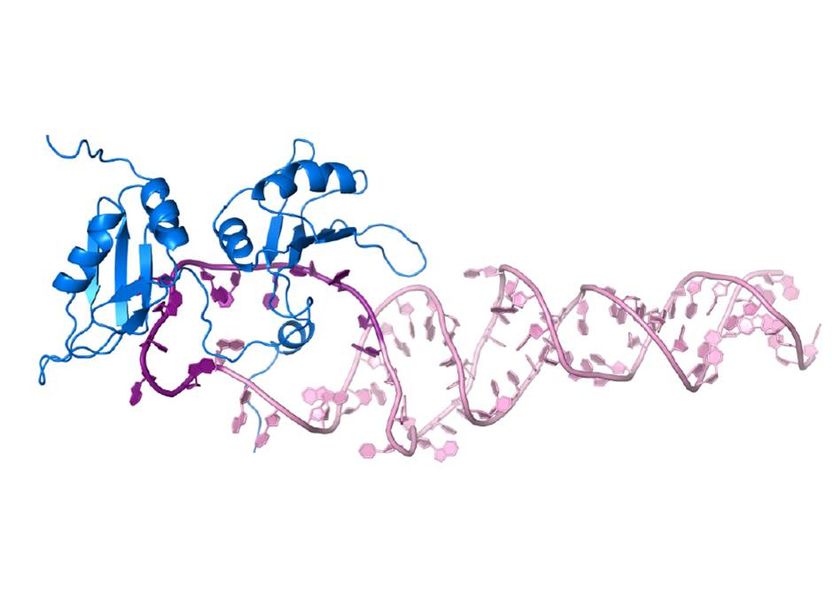New insight into the maturation of miRNAs
An international research team led by Helmholtz Zentrum München, Technical University of Munich and the University of Edinburgh has used an integrated structural biological approach to elucidate the maturation of a cancer-causing microRNA in gene regulation. In the future, the authors hope to develop new therapies based on the findings.

The authors were able to show exactly how a specific RNA binding protein (blue) recognizes pri-miR-18a (pink) and changes its structure in such a way that it develops into mature miRNA-18a.
Picture modified from Kooshapur et al.
MicroRNAs (miRNAs) are a class of molecules consisting of short RNA sequences that inhibit the formation of certain proteins by destroying the corresponding RNA blueprint.
Cancer-causing miRNAs, so-called oncomiRs, also function according to this principle and inhibit the production of proteins that protect the cell against uncontrolled growth. "Thus, an increased presence of these molecules in cells leads to the development of cancer in the long term," said Professor Michael Sattler, director of the Institute of Structural Biology at Helmholtz Zentrum München and professor of Biomolecular NMR Spectroscopy at the Technical University of Munich. "However, some molecular mechanisms of miRNA maturation in the cell remain elusive.”
Usually, before a miRNA can act in the cell, it undergoes several maturation steps and develops from a so-called primary pri-miRNA via a precursor stage (pre-miRNA) to a mature miRNA. In the current study, Professor Sattler together with researchers led by Professor Javier Caceres and Dr. Gracjan Michlewski from the University of Edinburgh and his former doctoral student Hamed Kooshapur (now at the National Institutes of Health, USA), investigated the maturation of a specific pri-miRNA.
"Our research focused on the maturation of miRNA-18a, which has been associated with colon, breast, and esophageal cancer,” said Michael Sattler. "To elucidate how its maturation is controlled, we had to combine different procedures. Nuclear magnetic resonance (NMR) spectroscopy, X-ray crystallography, small-angle X-ray scattering analyses as well as biochemical experiments were used."
Using this combination approach, the authors were able to show exactly how a specific RNA binding protein (hnRNP A1) recognizes pri-miRNA-18a and changes its structure in such a way that it develops into mature miRNA-18a. The researchers assume that the mechanism can also be transferred to other miRNAs. "In the long term, understanding the processes might help us to develop new therapy options – for example to treat cancer," said Sattler. "Only if we understand how biology works we can intervene in a targeted manner."
Original publication
Hamed Kooshapur, Nila Roy Choudhury, Bernd Simon, Max Mühlbauer, Alexander Jussupow, Noemi Fernandez, Alisha N. Jones, Andre Dallmann, Frank Gabel, Carlo Camilloni, Gracjan Michlewski, Javier F. Caceres & Michael Sattler ; "Structural basis for terminal loop recognition and stimulation of pri-miRNA-18a processing by hnRNP A1"; Nature Comm.; 2018
Other news from the department science
Most read news
More news from our other portals
See the theme worlds for related content
Topic World Spectroscopy
Investigation with spectroscopy gives us unique insights into the composition and structure of materials. From UV-Vis spectroscopy to infrared and Raman spectroscopy to fluorescence and atomic absorption spectroscopy, spectroscopy offers us a wide range of analytical techniques to precisely characterize substances. Immerse yourself in the fascinating world of spectroscopy!

Topic World Spectroscopy
Investigation with spectroscopy gives us unique insights into the composition and structure of materials. From UV-Vis spectroscopy to infrared and Raman spectroscopy to fluorescence and atomic absorption spectroscopy, spectroscopy offers us a wide range of analytical techniques to precisely characterize substances. Immerse yourself in the fascinating world of spectroscopy!

























































